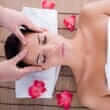Background
- In the early 1900s, the osteopathic doctor William Sutherand developed a theory that the relationships and motions of the bones of the skull (cranium), the fluid that flows through the brain and spinal column (cerebrospinal fluid), the membranes around the brain and spinal cord (meninges), and the bones of the lower back (sacrum) lie at the core of the body's functioning and vital energy.
- A series of techniques grew out of these concepts, which were further developed in the 1970s by John Upledger, also an osteopathic doctor. Dr. Upledger coined the term craniosacral therapy, which refers to a form of therapeutic manipulation that is oriented to tissue, fluid, membranes, and energy.
- Cranial manipulation has reportedly been practiced in India for centuries. In the 18th Century, a philosopher and scientist named Emmanuel Swedenborg claimed that the brain moves with regular cycles of expansion and contraction.
- Craniosacral therapy has been suggested as a treatment for various conditions, including asthma, cerebral palsy in children, headache, labor and delivery, low back pain, and torticollis in infants. However, there is a lack of scientific data on the safety and effectiveness of the therapy.
- Skeptics have raised various criticisms about craniosacral therapy. For example, some argue that scientific evidence does not support the theories for cranial bone movement since the cranial bones fuse during adolescence. Others argue that the cerebrospinal fluid pulsation is caused by the functioning of the cardiovascular system and not by the craniosacral system.
References
- Green C, Martin CW, Bassett K, et al. A systematic review of craniosacral therapy: biological plausibility, assessment reliability and clinical effectiveness. Complement Ther Med 1999;7(4):201-207.
View Abstract - Greenman PE, McPartland JM. Cranial findings and iatrogenesis from craniosacral manipulation in patients with traumatic brain syndrome. J Am Osteopath Assoc 1995;95(3):182-188.
View Abstract - Hartman SE, Norton JM. Craniosacral therapy is not medicine. Phys Ther 2002;Nov, 82(11):1146-1147.
View Abstract - Hanten WP, Dawson DD, Iwata M, et al. Craniosacral rhythm: reliability and relationships with cardiac and respiratory rates. J Orthop Sports Phys Ther 1998;Mar, 27(3):213-218.
View Abstract - Hehir B. Head cases: an examination of craniosacral therapy. Midwives (Lond) 2003;Jan, 6(1):38-40.
View Abstract - Maher CG. Effective physical treatment for chronic low back pain. Orthop Clin North Am 2004;35(1):57-64.
View Abstract - McPartland JM, Mein EA. Entrainment and the cranial rhythmic impulse. Altern Ther Health Med 1997;Jan, 3(1):40-45.
View Abstract - Mehl-Madrona L, Kligler B, Silverman S, et al. The impact of acupuncture and craniosacral therapy interventions on clinical outcomes in adults with asthma. Explore (NY). 2007 Jan-Feb;3(1):28-36.
View Abstract - Moran RW, Gibbons P. Intraexaminer and interexaminer reliability for palpation of the cranial rhythmic impulse at the head and sacrum. J Manipulative Physiol Ther 2001;Mar-Apr, 24(3):183-190.
View Abstract - Phillips CJ, Meyer JJ. Chiropractic care, including craniosacral therapy, during pregnancy: a static-group comparison of obstetric interventions during labor and delivery. J Manipulative Physiol Ther. 1995 Oct;18(8):525-9.
View Abstract - Quaid A. Craniosacral controversy. Phys Ther 1995;Mar, 75(3):240. Comment in: Phys Ther 1994;Oct, 74(10):908-916. Discussion, 917-920.
View Abstract - Rogers JS, Witt PL, Gross MT, et al. Simultaneous palpation of the craniosacral rate at the head and feet: intrarater and interrater reliability and rate comparisons. Phys Ther 1998;Nov, 78(11):1175-1185.
View Abstract - Rogers JS, Witt PL. The controversy of cranial bone motion. J Orthop Sports Phys Ther 1997;Aug, 26(2):95-103.
View Abstract - Upledger JE. Craniosacral therapy. Phys Ther 1995;Apr, 75(4):328-330. Comment in: Phys Ther 1994;Oct, 74(10):908-916. Discussion, 917-920.
View Abstract - Wirth-Pattullo V, Hayes KW. Interrater reliability of craniosacral rate measurements and their relationship with subjects' and examiners' heart and respiratory rate measurements. Phys Ther 1994;Oct, 74(10):908-916. Discussion, 917-920. Comment in: Phys Ther 1995;Apr, 75(4):328-330. Phys Ther 1995;Mar, 75(3):240.
View Abstract







